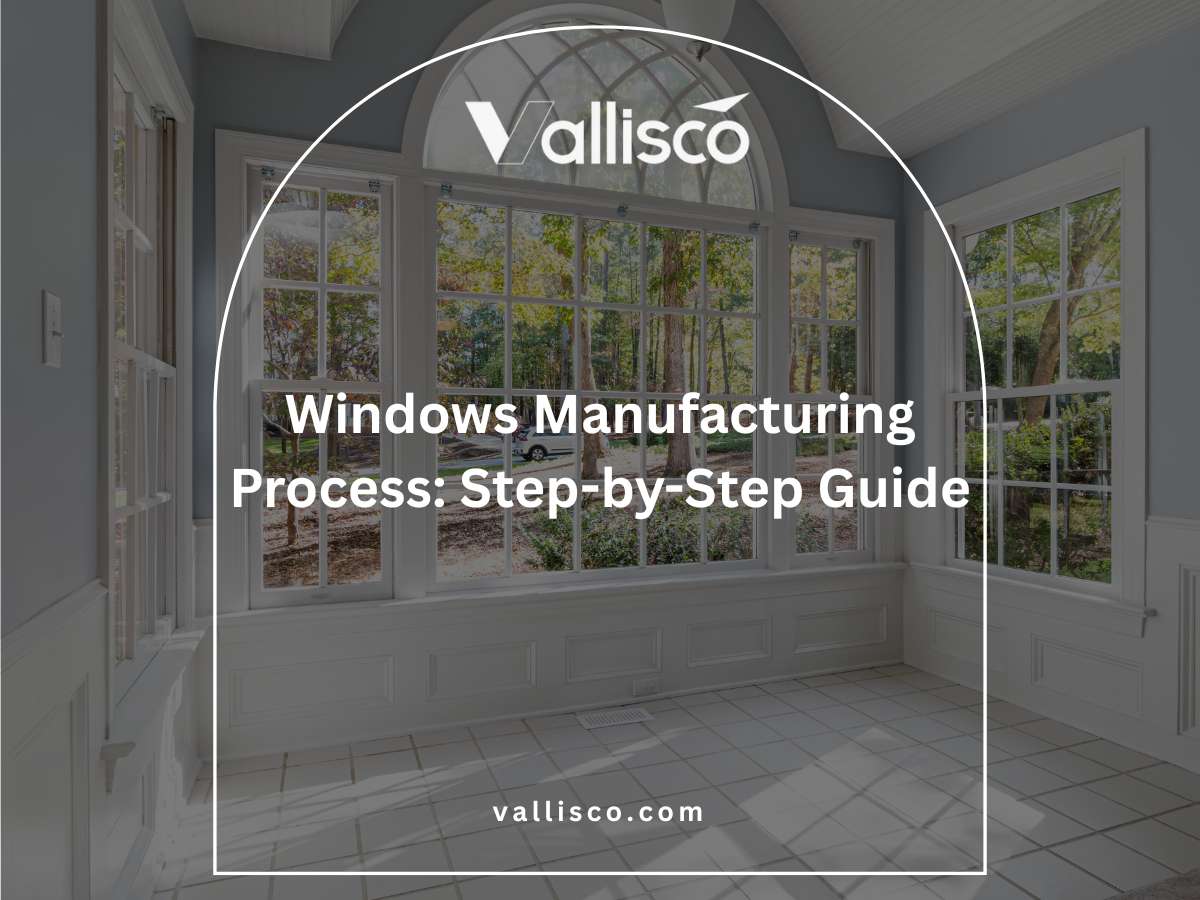During a villa project in Europe, the owner told me the bathroom doors kept banging into fixtures. It was a simple detail, but it made the space hard to use.
This is a problem many owners face when planning bathroom spaces in apartments, villas, and hotels.
I’ve supplied doors for large and small projects for years. From budget inns to luxury villas, I’ve seen what lasts and what fails. That’s why you can trust this review to be practical, not theoretical.
In the next sections, you’ll find 8 door styles that work well in apartment bathrooms. I’ll explain their benefits, limits, and where they fit best.
Small choices like bathroom doors can shape the comfort of an entire property. Getting it right matters.
So, let’s get started!
Quick Comparison Chart
Let’s get you oriented. Here’s a fast side-by-side to help you spot which apartment bathroom door might fit your project.
| Door Style | Space Saving | Privacy Level | Moisture Resistance | Sound Control | Installation Difficulty | Best For |
| Sliding Door | High | Medium to High | Moderate | Medium | Moderate | Tight hallways, modern apartments |
| Pocket Door | Very High | Medium to High | Moderate | Medium | High | New builds, small spaces, seamless look |
| Standard Swing Door | Low | High | Depends on material | High | Low | Larger units, fast builds, easy replacements |
| Bifold Door | Medium | Medium | Low to Moderate | Low to Medium | Low to Moderate | Narrow entries, budget builds |
| Barn Door (Wall-Mounted) | High | Low to Medium | Moderate | Low | Moderate | Stylish interiors, wall clearance available |
| Frosted Glass Door | Varies | Medium | High | Low to Medium | Moderate | Bright bathrooms, modern rentals |
| PVC Door | High | High | Very High | Low to Medium | Low | Humid climates, low-maintenance projects |
| Aluminum Frame w/ Glass Panel | Medium | Medium | High | Medium | Moderate | Villas, hotels, modern apartments, long-term projects |
Got a better sense of your options? Let’s go deeper into each door so you can choose with clarity.
1. Sliding Door
When you’re choosing doors for bathrooms in apartments, villas, or hotels, it’s not just about looks. The right style affects how space works day after day. I’ve seen projects where the wrong door caused daily frustration, like the villa job I mentioned earlier, and others where the right choice solved problems before they even started.
Ideal For:
- Apartments
- Villas
- Hotels
- Inns
- B&Bs
Technical Specs
- Material Options: Wood, PVC, metal, and glass. Each reacts differently to moisture. For instance, I’ve seen wood swell in damp climates if not treated, while PVC stays stable.
- Opening Mechanism: Swing, sliding, folding, or pocket. The decision usually depends on how much floor space you can spare.
- Moisture Resistance: Some projects need doors that are fully waterproof. Others can manage with doors coated to resist everyday humidity.
- Standard Sizes: Most doors for apartment bathrooms measure 28–32 inches wide. Hotels or villas often need bigger or custom-built options.
Pros & Cons
Pros
- Variety of Choices: You can find a style that matches your property’s design, from simple to high-end.
- Space Planning Flexibility: Sliding and pocket doors fit tight layouts, while swing doors work where space is less restricted.
- Cost Options: PVC, glass, or wood—there are solutions for budget-sensitive projects and also for premium builds.
Cons
- Not a One-Size-Fits-All: What works in a villa may not suit an apartment with limited space.
- Maintenance Needs: Wood requires regular care, while glass and PVC demand frequent cleaning.
- Installation Effort: Some styles, like pocket doors, take more time and labor to set up.
Bottom Line
From my experience, door style decisions are often underestimated. The right choice improves daily use, airflow, and comfort for guests or residents. In a hotel or villa, that can mean smoother cleaning routines and fewer complaints.
Still, every style has trade-offs. Some cost more to install, others need constant upkeep. As you read through the styles in this guide, think about how your property operates every day. The best door is the one that balances function, durability, and budget without creating new problems down the line.
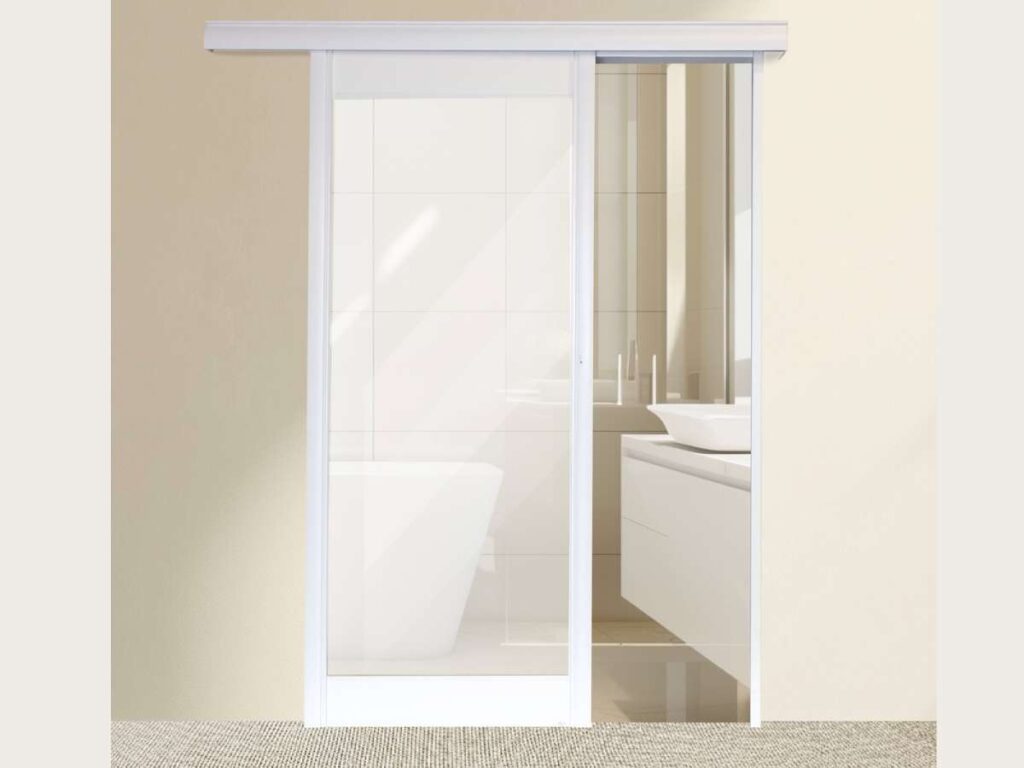
2. Pocket Door
I remember working on a small apartment renovation where the bathroom was only a few square meters. The owner wanted more space for fixtures, but the standard swing door kept getting in the way. A pocket door solved the issue immediately by sliding into the wall and disappearing when open.
Ideal For:
- Apartments with tight bathrooms
- Villas with modern interiors
- Hotels with compact layouts
- Guest houses
- B&Bs with small room designs
Technical Specs
- Space Requirement: Needs a hollow wall cavity to slide into. This means you must plan for it early in construction or renovation.
- Track and Frame: Runs on a concealed track system with a steel or aluminum frame. Proper installation is key to avoid sticking.
- Door Material: Can be made of wood, PVC, or glass, depending on the property’s style and moisture levels.
- Width Range: Typically 28–36 inches. Wider doors are possible for villas or large bathrooms.
Pros & Cons
Pros
- Space Saver: Opens up the bathroom by removing the swing radius of a standard door.
- Clean Look: Because it slides into the wall, the door doesn’t clutter the space.
- Flexible Design: Works with different materials and finishes, so it can fit modern or traditional projects.
Cons
- Complex Installation: Requires wall modification, which can be costly and time-consuming.
- Maintenance Access: If the track fails, repair can be harder since it’s hidden inside the wall.
- Not Always Possible: Older buildings with solid walls may not allow pocket door installation.
Bottom Line
Pocket doors are excellent for properties where every inch counts. In apartments, they can free up wall space for sinks or storage. In hotels, they keep the bathroom layout simple and accessible.
But there are trade-offs. Installation is not always easy, and repairs can be inconvenient. If you are building new or doing a major renovation, it’s worth considering. For quick retrofits, though, other door styles may be more practical.
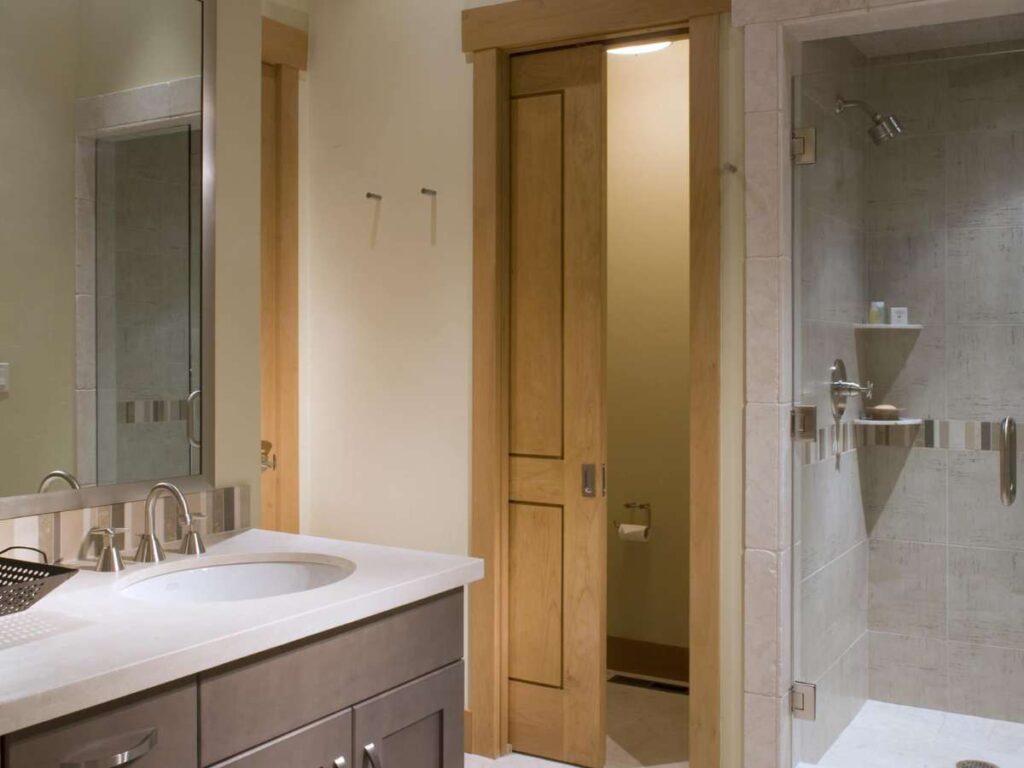
3. Standard Swing Door (Hinged Door)
In many projects, a standard swing door is the first option that comes to mind. It’s straightforward, easy to install, and familiar for both owners and guests. I’ve seen it work well in budget apartments as well as luxury villas because of its practicality.
Ideal For:
- Apartments
- Villas
- Hotels
- Inns
- B&Bs
Technical Specs
- Operation: Hinged on one side and swings open, either inward or outward depending on the space. Inward swing is common but can limit interior layout.
- Material Options: Often made from solid wood, engineered wood, metal, or PVC. The choice depends on humidity levels and budget.
- Standard Size: Usually 28–32 inches wide. Larger villas and hotels sometimes use wider doors for comfort and accessibility.
- Hardware: Requires hinges, handles, and locks. Stainless steel or brass hardware is recommended for durability in humid environments.
Pros & Cons
Pros
- Widely Available: Easy to source and quick to install in most projects.
- Budget Friendly: Offers affordable options while still being durable if the right material is used.
- Reliable Function: Straightforward to operate, making it convenient for guests and staff alike.
Cons
- Space Requirement: Needs clearance for the swing, which can interfere with fixtures or movement.
- Moisture Risk: Wooden versions can warp in damp areas if not properly treated or sealed.
- Design Limitations: Standard look may not suit projects aiming for a modern or space-saving design.
Bottom Line
Standard swing doors are dependable and familiar. They’re a safe choice for many types of properties, especially if you want something simple and functional. For house or hotel owners, they’re often the go-to because they’re affordable and easy to maintain.
But they do have their limits. Swing doors need clear floor space, which can be a drawback in smaller apartments or compact hotel bathrooms. Before choosing them, think carefully about the available space and how often the door will be used.
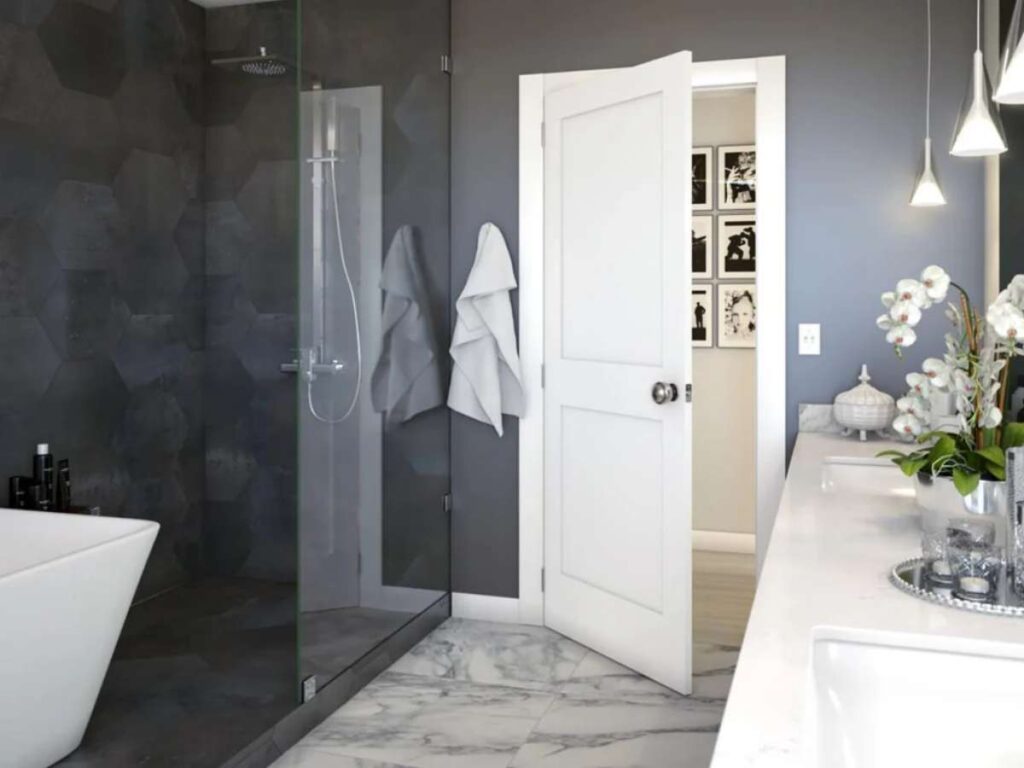
4. Bifold Door
During the villa renovation I worked on, the owner struggled with a bathroom that felt cramped. A full swing door kept colliding with the sink, and even a sliding option wasn’t ideal. A bifold door turned out to be the best fit, folding neatly and leaving more usable space inside.
Ideal For:
- Apartments
- Villas
- Hotels
- B&Bs
- Guest houses
Technical Specs
- Operation: Made of two or more panels that fold in on themselves when opened. Hinges connect the panels, and the door moves along a track.
- Space Use: Requires less swing space than a traditional hinged door. It’s practical for tight layouts where every inch matters.
- Material Options: Commonly available in PVC, wood, or aluminum. PVC versions hold up well in humid environments like bathrooms.
- Standard Sizes: Usually 24–36 inches wide, but custom widths are available for larger openings in villas or hotels.
Pros & Cons
Pros
- Compact Design: Saves space by folding instead of swinging out, which is helpful in small bathrooms.
- Lightweight: Easier to open and close compared to heavier swing doors.
- Affordable: Many bifold doors are cost-effective, making them attractive for budget-conscious projects.
Cons
- Less Durable: Hinges and tracks may wear faster compared to standard swing doors.
- Limited Privacy: Gaps between panels can sometimes reduce soundproofing and privacy.
- Maintenance: Tracks need cleaning to prevent dirt buildup, especially in hotels or villas with frequent use.
Bottom Line
Bifold doors work well when space is tight, and you still want a door that’s easy to use. I’ve seen them solve layout issues in both apartments and B&Bs where every square meter is important. They give owners flexibility without needing major changes to the bathroom structure.
Still, they do come with drawbacks. They’re not as strong as solid swing doors and can need more upkeep over time. If you’re working on a project where bathrooms are small and the budget is limited, Vallisco’s bifold door can be a smart option.
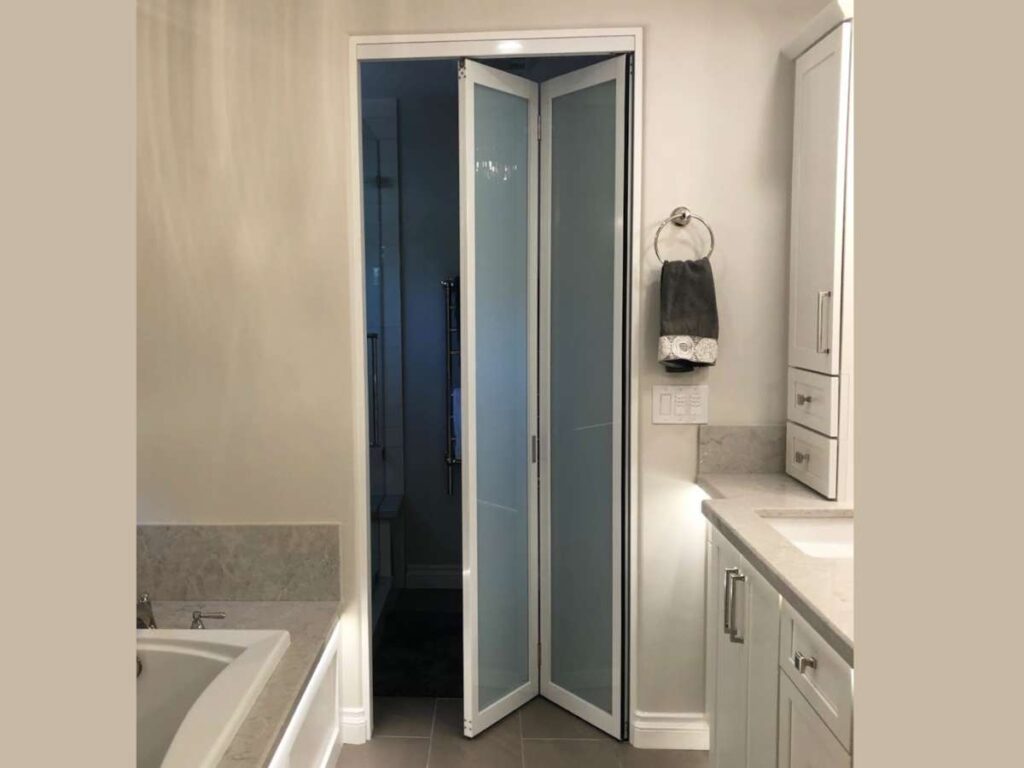
5. Barn Door (Wall-Mounted Sliding)
In one hotel project I supported, the owners wanted the bathrooms to feel more open and modern. Swing doors were taking up too much floor space, and pocket doors were not an option because of solid concrete walls. A wall-mounted barn door solved the problem, sliding smoothly along the wall and freeing up the layout.
Ideal For:
- Apartments
- Villas
- Hotels
- Inns
- B&Bs
Technical Specs
- Operation: The door hangs on a track mounted above the wall and slides sideways to open or close. It stays visible even when pushed aside.
- Wall Space Requirement: Needs enough wall area for the door to slide completely out of the way. Without it, the door won’t fully open.
- Material Choices: Popular options include wood, engineered wood, PVC, and even glass. Each gives a different look, from rustic to modern.
- Hardware: Requires a strong track and rollers. Stainless steel or powder-coated hardware is often used to handle daily wear.
Pros & Cons
Pros
- Space Efficient: Removes the need for swing clearance, which frees up floor area in compact bathrooms.
- Design Appeal: Offers a modern or rustic look that can add character to apartments, hotels, and villas.
- Easy Operation: Simple sliding motion makes it convenient for guests and staff to use.
Cons
- Privacy Limits: Since the door does not seal tightly against the wall, sound and light may pass through.
- Wall Space Needed: Requires enough open wall surface, which is not always possible in small layouts.
- Maintenance: Tracks and rollers need periodic checks to prevent noise or uneven sliding.
Bottom Line
Barn doors bring both style and function. I’ve seen them used in villas to give a modern design statement, and in hotels to save space without the need for heavy construction. They can help your property stand out with a fresh look while solving layout issues.
That said, they are not perfect. You’ll need to check your wall space before choosing this option, and privacy may not be as strong as with hinged or pocket doors. Still, if your property values design and space efficiency, a barn door is a solid choice.
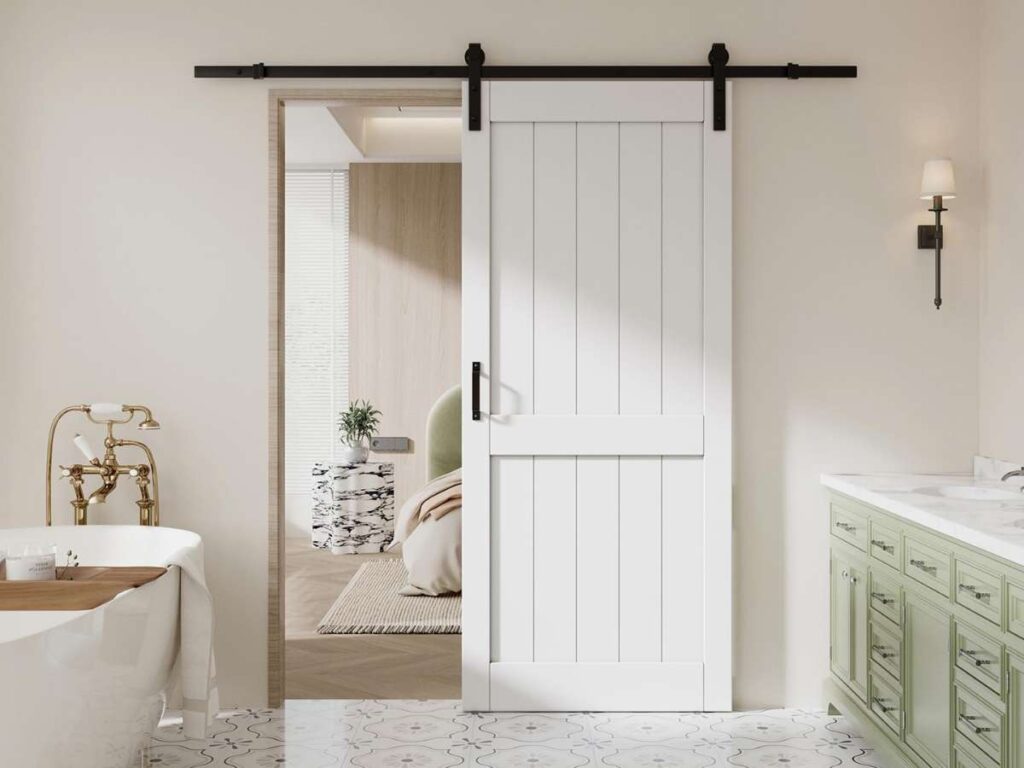
6. Frosted Glass Door
Frosted glass doors are popular in many modern projects because they balance privacy with light. They give bathrooms a brighter look while still keeping the space discreet. This combination works well in both small apartments and larger properties like villas or hotels.
Ideal For:
- Apartments
- Villas
- Hotels
- B&Bs
- Greenhouses
Technical Specs
- Glass Finish: Frosted coating diffuses light while blocking direct visibility. Options include acid-etched, sandblasted, or film-applied finishes.
- Frame Types: Can be framed with aluminum, wood, or left frameless for a sleek appearance. Framed designs are more durable in high-use areas.
- Thickness: Usually ranges between 8–12 mm for durability and safety. Thicker glass holds up better for hotels or villas with heavy use.
- Maintenance: Needs regular cleaning to prevent water spots and smudges. Non-porous glass is easier to maintain than treated wood or PVC.
Pros & Cons
Pros
- Natural Light: Allows light into the bathroom, which helps smaller apartments or hotels feel more open.
- Modern Look: Matches well with contemporary interiors, adding a polished appearance to any property.
- Durability: Tempered glass is strong and resists warping or swelling in humid conditions.
Cons
- Privacy Limits: While it blurs visibility, shadows and movement can still be seen. Not always ideal for shared bathrooms.
- Cleaning Needs: Shows fingerprints and water stains more clearly, so maintenance must be consistent.
- Cost Factor: Quality frosted glass can be more expensive than standard wood or PVC doors.
Bottom Line
Frosted glass doors bring a fresh, clean look to bathrooms while making the space feel brighter. I’ve seen them work especially well in hotels where modern design is important, and in villas where owners want a more open feeling without giving up privacy.
Still, they are not right for every project. They require regular upkeep to stay presentable, and privacy may not be enough for some layouts. If you want a bathroom door that feels light, modern, and functional, a frosted glass door from Vallisco is worth considering.
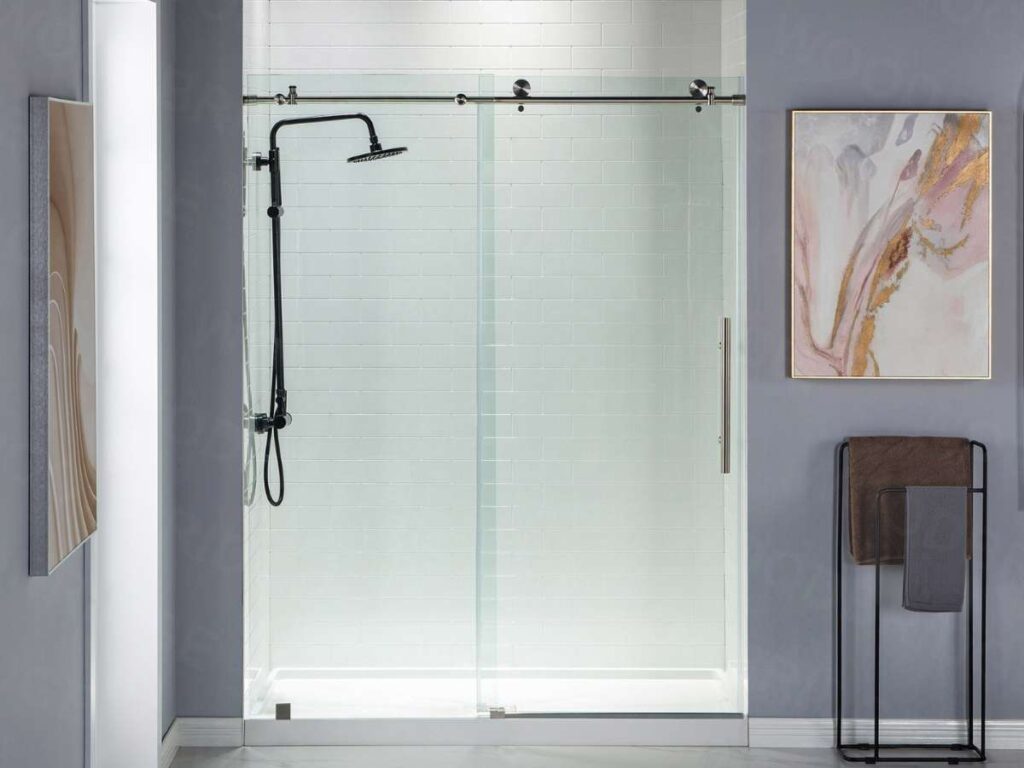
7. PVC Door
PVC doors are often chosen in projects where moisture is a constant challenge. They are lightweight, affordable, and resistant to water damage, making them a reliable option for many bathroom installations. For property owners who want something practical and low-maintenance, PVC is often a strong contender.
Ideal For:
- Apartments
- Villas
- Hotels
- B&Bs
- Inns
Technical Specs
- Material: Made from polyvinyl chloride, a plastic that resists moisture and does not warp in humid environments.
- Weight: Lighter than wood or glass, which makes installation faster and easier.
- Finishes: Can mimic the look of wood or come in plain solid colors, depending on the project’s design needs.
- Durability: While resistant to water, they may not be as strong as hardwood or tempered glass in the long term.
Pros & Cons
Pros
- Water Resistance: PVC does not absorb moisture, making it ideal for bathrooms in humid climates.
- Low Cost: Generally more affordable than wood or glass doors, which helps when managing large-scale projects.
- Easy Maintenance: Simple to clean and does not require sealing or refinishing.
Cons
- Lower Strength: PVC is not as strong as wood or metal doors and may dent or scratch more easily.
- Design Limitations: While finishes have improved, they may not provide the same premium look as real wood or glass.
- Heat Sensitivity: Can warp or discolor if exposed to extreme heat over time.
Bottom Line
PVC doors are a practical choice for many properties, especially in Southeast Asia where humidity is high. I’ve recommended them to villa owners that need durable bathroom doors without spending heavily on materials like hardwood or glass. Their resistance to water damage makes them dependable for long-term use in damp environments.
That being said, PVC doors are not the most stylish or strongest option available. For high-end properties where design impact is a priority, they may not deliver the desired look.
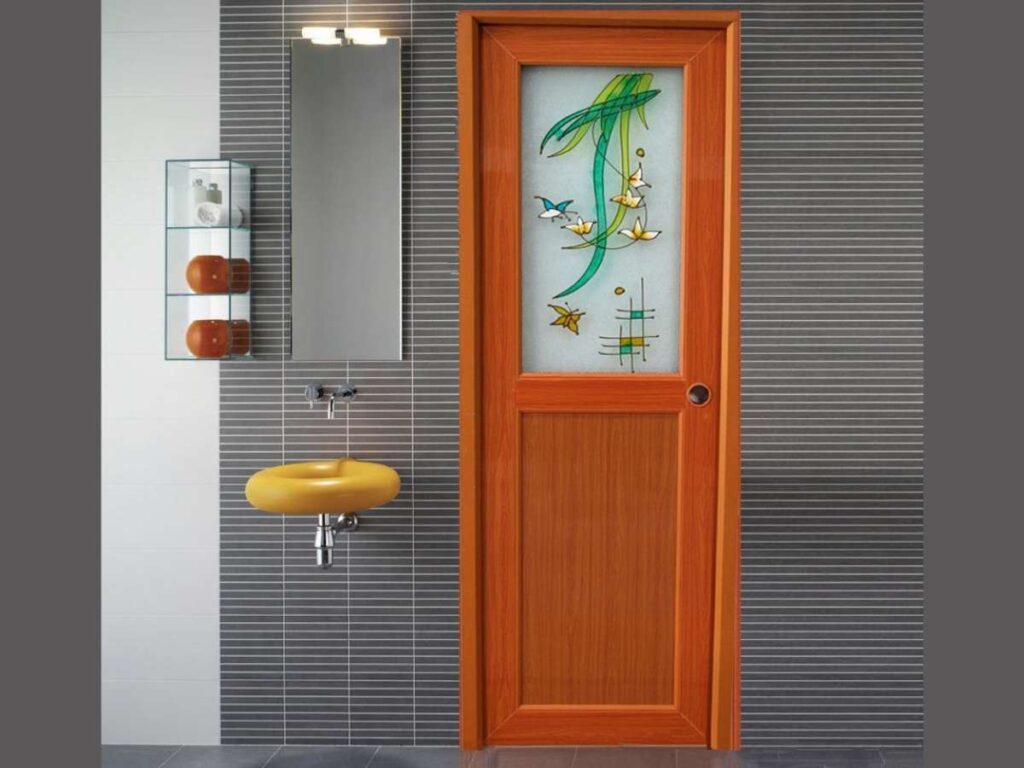
8. Aluminum Frame Door with Glass Panel
Aluminum frame doors with glass panels are often used in projects that need a balance of durability and design. The aluminum provides strength while the glass keeps the bathroom looking bright and modern. This combination works well for properties that want a clean look without sacrificing long-term performance.
Ideal For:
- Apartments
- Villas
- Hotels
- B&Bs
- Inns
Technical Specs
- Frame Material: Made from aluminum, which resists rust and holds up well in humid bathroom environments. It’s lightweight but strong enough for daily use.
- Glass Options: Panels can be frosted, clear, or tinted depending on privacy needs. Frosted glass is the most common for bathrooms.
- Design Flexibility: Frames can be powder-coated in different colors to match the overall design scheme.
- Durability: Stronger than PVC and less prone to warping compared to wood, making it a long-lasting choice.
Pros & Cons
Pros
- Moisture Resistant: Aluminum does not rust easily and is well-suited for damp environments like bathrooms.
- Modern Appearance: The combination of slim frames and glass panels gives a sleek, professional look to villas and hotels.
- Lightweight Strength: Offers a good balance between strength and lightness, making it easier to install and maintain than heavier doors.
Cons
- Privacy Concerns: Clear or lightly frosted glass may not give enough privacy in all settings. Careful choice of glass type is necessary.
- Cost: Higher-quality aluminum and glass combinations can cost more than PVC or standard wood doors.
- Cleaning Needs: Glass shows smudges and water stains, requiring frequent cleaning to stay presentable.
Bottom Line
Aluminum frame doors with glass panels are a solid choice for properties that want both function and style. I’ve seen them used in hotels where design matters as much as durability, and they often make small bathrooms feel larger by letting in more light. They bring a clean, modern finish that appeals to many B2B clients.
Still, they aren’t without trade-offs. You’ll need to budget for higher costs compared to PVC or basic wood, and plan for more cleaning to keep them looking fresh. If your project values modern aesthetics along with strength and water resistance, this type of door is a strong option worth considering.
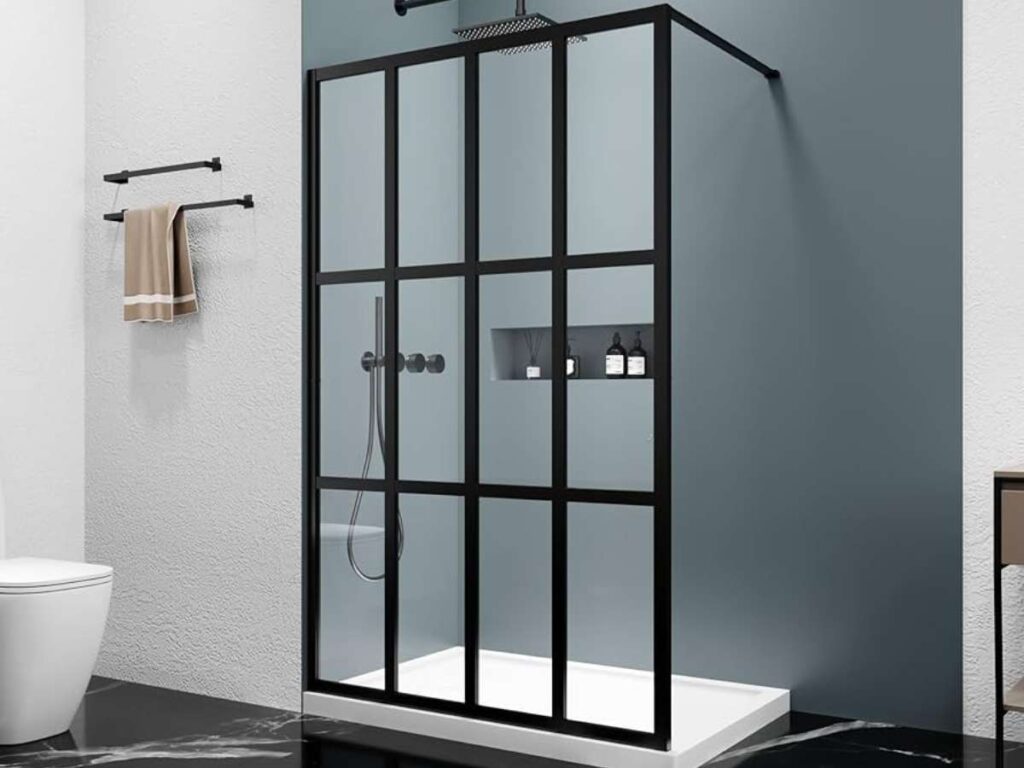
Conclusion
From pocket doors to PVC, each style has strengths and limits. What I’ve seen again and again is that the right choice makes bathrooms easier to use, easier to clean, and easier to maintain.
That villa story was just one example, small details like a door can decide comfort across an entire property.
You now have a clear view of 8 proven door styles. Think about how each fits your project’s layout and budget.
And when you’re ready for expert support, contact Vallisco today. We’ll help you source bathroom doors that make sense for your property.
Discover More Options
For more helpful content, explore our collection of recommended reads:
Still haven’t found what you’re looking for? Don’t hesitate to contact us. We’re available around the clock to assist you.



